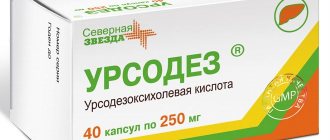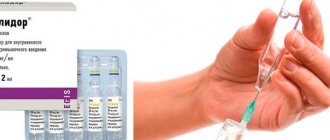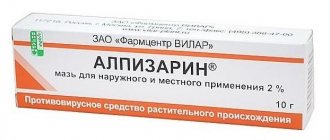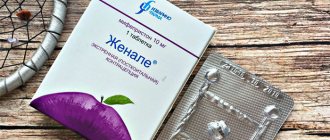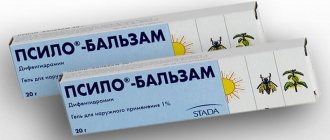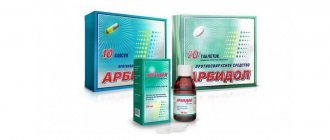Composition and release form
The drug Vazaprostan is available in the form of lyophysiate (powder obtained by lyophisization), which is intended for the preparation of a solution for intra-arterial or intravenous infusions. The medicine is a milky-white hygroscopic mass, packaged in glass ampoules of 10 pieces in a cardboard box. The main active component of the drug is aprostadil (20, 60 mcg). The medicine contains auxiliary components: alfadex, anhydrous lactose.
Description
The developers offer the medicine Vazaprostan in powder form or in the form of a lyophilisate. This dosage form is made for the production of infusion solution. The base substance is alprostadil. You can only really buy medicine in ampoules; there will be 10 ampoules in one box.
Based on the dosage of the active component, you can purchase Vazaprostan 60 mcg, as well as Vazaprostan 20 mcg. Alfadex and lactose are included as auxiliary ingredients in the drug formula, but these substances do not exhibit pronounced pharmaceutical activity.
The medicinal product belongs to several groups: angioprotectors and microcirculation correctors, as well as prostaglandins, thromboxanes, leukotrienes and their antagonists.
How does Vazaprostan work?
The drug Vazaprostan has a strong antiaggregation effect, which consists of suppressing the ability of platelets to aggregate, their resistance to deformation and reducing the risk of blood clots. The mechanism of this effect is associated with blocking thromboxane synthetase enzymes, blocking the transformation of arachidonic acid and reducing the concentration of intracellular calcium. Antiplatelet agents are used for the treatment and prevention of:
- ischemic pathologies;
- thrombosis;
- bleeding disorders (coagulopathy).
One of the main mechanisms of the hypotensive effect of this drug is the vasodilatory effect due to a decrease in smooth muscle tone. The medication acts on the smooth muscle cells of small arteries and arterioles. As a result of this process, the total peripheral resistance decreases, blood pressure decreases, and the minute and stroke volume of the heart and heart rate reflexively increase.
Reviews
On the Internet you can find a large number of reviews of Vazaprostan, left by both doctors and patients who have used the drug.
Patients note the high effectiveness of the drug even in the most severe cases, as well as relatively good tolerability. However, some patients experienced unwanted side effects.
The most common symptoms were weakness, dizziness, decreased blood pressure, nausea and swelling at the injection site.
Patients consider the most important disadvantage of Vazaprostan to be its high cost. Some patients claim that more affordable analogues are in no way inferior to the original drug.
Pharmacodynamics and pharmacokinetics of action
The pharmacological agent has a vasoprotective effect. Vazaprostan increases peripheral blood flow and microcirculation. Systemic administration of the drug leads to relaxation of smooth muscle fibers, expansion of the lumen of blood vessels, and a decrease in total peripheral vascular resistance (TPVR), without affecting blood pressure.
There is a reflex increase in heart rate (HR) and cardiac output. The medication suppresses the process of platelet aggregation, enhances erythrocyte elasticity and fibrinolytic activity of the blood, and reduces the activity of neutrophils. In addition, the drug is characterized by a significant stimulating effect on the smooth muscles (myometrium) of the uterus, bladder and intestines.
The medication is administered intra-arterially or intravenously in combination with alpha-cyclodextrin. When preparing the drug using saline, separation occurs into alpha-cyclodextrin and PGE1. The therapeutic concentration of the active component when administered intravenously is observed a few minutes after administration, the maximum concentration is reached after 100–120 minutes. Due to the fact that PGE 1 is an endogenous substance, its half-life is very short (5-7 minutes).
The substance PGE1 binds to plasma proteins by approximately 93%. Its metabolism process is mainly carried out by the lungs, with the formation of several breakdown products (15-keto - PGE1; 15-keto - PGE0 and PGE0). 60–90% of the active substance undergoes biotransformation. Metabolites are excreted from the body within 72 hours through the gastrointestinal tract (GIT), with urine (88%).
Pharmacodynamics/pharmacokinetics
Alprostadil is a metabolic participant. Under its action, the process of metabolizing oxygen and glucose is accelerated, the release of free radicals and lysosomal enzymes is suspended. The same active component blocks the production of cholesterol, as well as low-density lipoproteins. So, it turns out that Vazaprostan is also used in weight loss: more precisely, this is its parallel task, but not the main one. The composition of the drug reduces the rate of formation of the fat layer. All these phenomena lead to the fact that:
- The medicinal product, although indirectly, still affects the regenerative processes in tissues and the healing of ulcers;
- It reduces the intensity of pain that is associated with increased vascular tone;
- The medicine also has a good effect on the pelvic organs - the uterus and rectal canal, bladder;
- The drug helps to normalize the functions of male and female genital organs;
- Eliminates erectile dysfunction as it relaxes muscles and improves blood flow in the male reproductive organ.
But there is also a drawback to artificial prostaglandin E1 - it is quickly eliminated after completion of therapy. Metabolism occurs in the lungs, transforming up to 70% of the composition. The elimination period takes about three days; the released metabolite is evacuated from the body through the gastrointestinal tract and kidneys. The active ingredient binds to plasma proteins by 93%.
Instructions for use
To prepare the required form of the drug, saline solution (50–250 ml) is added to the lyophilisate. According to the instructions for use, the medication should be prepared before injection into an artery or vein. It is unacceptable to store the product until the next use. The powder dissolves immediately, but after adding saline solution, the product may turn out cloudy. This effect occurs due to the large number of air bubbles and does not have any negative effect. After a few minutes, the medicine becomes transparent and colorless. Peculiarities:
- The duration of drug therapy with Vazaprostan is on average 2–4 weeks.
- If the therapeutic effect is insufficient or the patient’s condition is serious, the course of treatment is extended as directed by the attending physician.
- Patients suffering from insufficient functioning of the kidneys, liver, or cardiovascular system require individual selection of the dose of the drug.
Article on the topic: Radon baths for uterine fibroids
Intra-arterial administration of vazaprostan
To administer the drug into the arteries, the contents of the ampoule (20 mcg of alprostadil) are added to 50 ml of saline solution. Half of the resulting solution is administered intra-arterially using an infusion device over 1-2 hours. If necessary, the dosage should be doubled while monitoring tolerance. Typically, this amount of medication is used for a single daily infusion. Provided intra-arterial administration of the drug using an installed catheter, a dosage of 0.1–0.6 mcg/kg per minute with infusion over 12 hours is recommended.
Intravenous infusion
To obtain a solution for intravenous administration (IV), the contents of two ampoules of the drug (40 mcg of alprostadil) must be dissolved in 50–250 ml of saline solution, and the resulting solution must be injected into a vein over two hours. The medicine is used 2 times a day. Second option: the contents of three ampoules (60 mcg of active substance) are added to 50–250 ml of saline solution, administered intravenously by infusion over three hours, once a day.
What does it help with?
The main indication for Vazaprostan from the instructions for use is the development of obliterating diseases of the 3rd and 4th stages of the chronic course, which are accompanied by a decrease in the vascular lumen. The medicine is prescribed only if it is impossible to perform revascularization, or if such an operation was unsuccessful.
Vazaprostan may be prescribed for the following pathologies:
- Vasculitis is a group of diseases whose similarities are expressed by immunopathological inflammation of blood vessels. We can say that this is an autoimmune inflammation of the vascular walls.
- Angiopathy – it means vascular damage due to disturbances in nervous regulation. The disease is expressed in the form of dystonia, reversible spasms and vascular paresis.
- Endarteritis is a severe arterial disease, most often affecting the vessels of the lower extremities.
- Raynaud's disease is expressed by a violation of the arterial blood supply to the feet or hands; it refers to vasospastic diseases. The disease is characterized by paroxysmal character.
- Atherosclerosis of the lower extremities is a disease with a whole range of changes: blood is disrupted in its path through the vascular network, tissue trophism occurs, etc. Since atherosclerosis often deforms the large arteries of the thoracic and abdominal cavities, this leads to pathologies in the femoral and tibial arteries.
- Thromboangitis obliterans. This is a systemic, chronic process, for the most part, affecting veins and arteries of small and medium diameter.
- Erectile dysfunction is a situation when the volume of the penis, its density and size are insufficient for full sexual intercourse.
- Heart disease - only as a complex therapy and exclusively as a temporary therapeutic measure, the drug Vazaprostan is used in this case.
This medicine should not be taken without a doctor's prescription: it is quite serious, and such self-medication can aggravate the condition. Although it is almost impossible to do this (that is, take the medication yourself), it is administered by a medical professional.
Features of application
The medicine is allowed to be used if appropriate medical equipment is available. During therapy, constant medical supervision of the patient's condition is necessary. It is necessary to control blood pressure, heart rate, biochemical parameters and blood clotting ability. In addition, they monitor:
- body weight;
- changes in venous pressure;
- echocardiographic study indicators;
- fluid balance.
For renal failure and coronary artery disease
For patients who suffer from impaired renal function, intravenous administration of the drug should begin with 20 mcg over two hours. If indicated, after 2-3 days the dosage is increased to 40–60 mcg. For patients with heart and kidney failure, the amount of fluid administered should be no more than 50–100 ml/day. to prevent overhydration. The duration of treatment is 4 weeks.
With developing phlebitis
Inflammation of the veins (phlebitis) above the puncture site is not a reason to interrupt treatment. Symptoms of the disease stop a few hours after completing the infusion or changing the injection site. No specific therapy is required in such cases. Operative catheterization of the central vein will help reduce the manifestations of phlebitis.
Precautionary measures
In order to avoid disruption of blood clotting function, this composition is not prescribed in parallel with drugs from the group of anticoagulants or NSAIDs.
The following points are also taken into account:
- To avoid dehydration in people with renal failure, the volume of fluid introduced into the vessel should not exceed 50-100 ml per day.
- If necessary, the patient is monitored for daily diuresis and undergoes echocardiography.
- Patients with cardiac ischemia or renal failure should not go home immediately after administration of the drug. They remain in the hospital for another day.
- Since the main component can influence the speed of reactions, during treatment you should not drive a car or operate mechanisms that require a quick response.
Vazaprostan does not combine with strong drinks at all!
The medicine is not prescribed to children, pregnant women, breastfeeding women, or those who have hypersensitivity to any of the components.
In cases of overdose, a sharp drop in blood pressure, redness of the skin, dizziness and tachycardia, hemorrhage and hematuria can be expected. It is necessary to stop administering the medicine (in some cases it is enough to slow down its administration).
Side effects of the drug
Many substances that have a direct effect on the human body cause allergic reactions of varying strength and activate side processes. These additional effects of the active components of Vazaprostan entail negative consequences for the vital organs of the human body. The components of the drug affect the following organ systems:
- central nervous;
- cardiovascular;
- musculoskeletal system;
- respiratory.
In some cases, with long-term use of a pharmacological drug, manifestations of an allergic reaction and changes in laboratory blood test parameters are noted; arthralgia, convulsions of central origin, chills, and chest pain rarely occur. Possible dyspeptic syndrome (diarrhea, nausea). In clinical practice, acute pulmonary edema and left ventricular failure are sometimes observed. Hypoglycemia and convulsions are extremely rare, and a disseminated process in the lungs may occur.
Laboratory indicators
The use of the drug changes some indicators of biochemical and clinical blood tests: there is an increase in the number of leukocytes (leukocytosis) or a decrease (leukopenia), an increase in transminases (liver enzymes ALT, AST), and bilirubin levels (hyperbilirubinemia). It is possible that the C-reactive protein titer may change upward.
Allergic reactions
In case of individual intolerance to the components of a pharmacological agent, its entry into the bloodstream causes various allergic reactions:
- itching;
- skin rashes;
- pale skin;
- fever.
CNS
The active ingredient of the drug aptostadil can have a strong adverse effect on the condition and functioning of the central nervous system, which is manifested by the following symptoms:
- severe headache;
- convulsive syndrome;
- lethargy;
- increased fatigue;
- dizziness.
The cardiovascular system
From the cardiovascular system, as a rule, the following side effects occur:
- angina pectoris;
- decreased blood pressure (up to collapse);
- disturbance of cerebral and coronary blood flow;
- cardialgia (pain on the left side of the chest).
Effect on the musculoskeletal system
With drug therapy for more than four weeks, reversible hyperostosis (pathological increase in the amount of bone substance) of tubular or flat bones is possible. In the presence of metabolic pathologies, malnutrition or hereditary connective tissue diseases, inflammation and pain in the joints during movement and disruption of their normal function are noted.
General and local symptoms
Limited or local side effects are usually associated with improper administration of the drug, phlebitis or allergic reactions to the drug. Local symptoms include pain, redness, loss of sensitivity or swelling of the puncture site of the vessel. General or systemic side effects occur due to individual intolerance to the substances that make up the drug. These include:
- loss of consciousness;
- darkening of the eyes;
- dizziness;
- disorientation.
Article on the topic: Cardiomagnyl - instructions for use, indications, composition, release form, dosage and price
What negative reactions are possible?
Side effects are indeed predicted. Most often the nervous system reacts to the drug. On her part, headaches of varying intensity, convulsions, dizziness, lethargy and unusually rapid fatigue, and paresthesia may occur.
From other systems, undesirable reactions are as follows:
- Heart and blood vessels - heart rhythm disturbances, heart pain, decreased blood pressure;
- Musculoskeletal system - taking the medicine is fraught with hyperstosis of long tubular bones;
- Digestive organs – pain in the gastric region, dyspepsia, diarrhea;
- Allergic responses - dermal rash, hyperemia, itching, swelling of the mucous membranes and pain along the vessel;
- Others are hyperhidrosis, hyperthermia (or slight increase in temperature), confusion and breathing problems, anuria, joint pain.
The last paragraph lists extremely rare side effects. As for the tests, their picture can also change: the number of leukocytes often decreases, the level of liver transminases and C-reactive protein increases. In the vast majority of cases, all negative effects go away after lowering the dose of the medication or simply stopping it.
Contraindications for vazaprostan
Vazaprostan should be used with caution if there is a history of arterial hypotension or pathologies of the cardiovascular system (strict control is required); For patients with impaired excretory function who are on hemodialysis, therapy must be carried out in the post-dialysis period. People suffering from type 1 diabetes mellitus are prescribed with caution for extensive damage to the arteries and veins.
Direct contraindications for the use of the drug are:
- heart failure in the stage of decompensation;
- heart rhythm disturbances (arrhythmias);
- coronary heart disease in the acute stage;
- acute and subacute myocardial infarction;
- pulmonary edema;
- infiltrative lung lesions;
- anemia;
- chronic obstructive pulmonary disease;
- liver dysfunction;
- pathologies accompanied by a high risk of bleeding (gastric and duodenal ulcers, severe cerebral vascular damage, proliferative retinopathy);
- the need for concomitant treatment with anticoagulants;
- pregnancy;
- lactation period (breastfeeding);
- atrioventricular block;
- age under 18 years;
- increased individual sensitivity to the components of the drug.
More information about drug categories
Angioprotectors are a pharmacological group whose representatives are important in the complex therapy of various diseases of the cardiovascular system. Microcirculation correctors are medications that change the characteristics of blood inflow and outflow and improve microcirculation of the vascular network.
Prostaglandins are a group of lipid, physiologically active substances formed in the body through fermentation. They are derivatives of polyunsaturated fatty acids. Thromboxanes cause vasoconstriction and stimulate platelet aggregation. Leukotrienes are natural biological regulators involved in inflammatory reactions.
Interaction with other drugs
With simultaneous therapy, Vazaprostan enhances the effect of antihypertensive drugs, peripheral vasodilators, antianginal drugs (against angina). Combined use with platelet aggregation inhibitors, thrombolytics, anticoagulants (for example, Cefoperazone, Cefamandole, Cefotetan) significantly increases the risk of bleeding. The simultaneous use of Vazaprostan and adrenaline reduces the vasodilating effect. It is strictly forbidden to drink alcohol during treatment.
Side effects
When using Vazaprostan, it is possible to develop disorders in various body systems:
- Central and peripheral nervous system: headache, convulsions, dizziness, general weakness, increased fatigue, impaired sensitivity of the mucous membranes and skin;
- Cardiovascular system: heart rhythm disturbances, low blood pressure, chest pain, AV block;
- Musculoskeletal system: hyperostosis of long tubular bones (with a duration of therapy of more than 28 days);
- Digestive system: nausea, epigastric discomfort, diarrhea, vomiting;
- Local reactions: swelling, erythema, sensory disturbance, pain, phlebitis;
- Allergic reactions: itching, skin rash;
- Laboratory indicators: leukopenia, leukocytosis, increased transaminase levels, increased C-reactive protein titer;
- Other: hyperthermia, increased sweating;
- Rarely: confusion, arthralgia, fever, convulsions of central origin, bradypnea, chills, renal failure, psychosis, anuria;
- Extremely rare (less than 1% of cases): acute heart failure, shock, bleeding, hyperbilirubinemia, bradypnea, drowsiness, tachypnea, decreased respiratory function, impaired renal function, anuria, ventricular fibrillation, hypoglycemia, supraventricular arrhythmia, 2nd degree AV block, increased irritability, neck muscle tension, hypercapnia, hypothermia, hematuria, skin hyperemia, tachyphylaxis, anemia, thrombocytopenia, hyperkalemia.
Side effects associated with the use of Vazaprostan or the catheterization procedure are reversible after reducing the dosage or stopping the infusion.
Price of vazaprostan in Moscow pharmacies
In Russia, the drug Vazaprostan is dispensed from pharmacies strictly according to a doctor’s prescription. The cost of a medicine depends on the quality of its constituent ingredients, the region of its production and sale. You can buy the drug at an online pharmacy (in this case, as a rule, the prescription must be presented to the courier or at the point of delivery of orders). Approximate cost of Vazaprostan:
| Release form of the drug | Pharmacy name | Cost, in rubles |
| Vazaprostan ampoules, 20 mcg, 10 pcs. | Piluli | 8971 |
| Avicenna | 9174 | |
| Vazaprostan ampoules, 60 mcg, 10 pcs. | Moscow pharmacy | 15681 |
| Apteka | 14640 | |
| Central Pharmacy | 15320 |
Overdose
Main symptoms: decreased blood pressure, increased heart rate, vasovagal reactions may develop (manifested in the form of increased sweating, pale skin, nausea, vomiting); this may be accompanied by symptoms of heart failure and myocardial ischemia; Swelling, redness of the tissue, and pain at the infusion site may also occur.
Therapy: reducing the dose of Vazaprostan or stopping the infusion. If there is a marked decrease in blood pressure, the patient is transferred to a lying position with legs elevated. If symptoms persist, sympathomimetics are prescribed.
Drug analogues
Pharmacological preparations intended to dilate blood vessels and improve blood supply to tissues differ in the degree of purification of the active substance, the presence and strength of side effects, method of administration and form of release. Consider effective analogues of Vazaprostan, compare their prices:
| Drug name | Active substance | Cost in rubles |
| Alprostan | Alprostadil | 5600 |
| Caverject | Alprostadil | 700 |
| VAP 20 | Alprostadil | 3270 |
| Alprostan Zentiva | Alprostadil | 5740 |
| Plavix | Clopidogrel | 7300 |
| Tiklid | Ticlopidine | 4219 |
| Chime | Dipyridamole | 548 |
| Vazonite | Pentoxifylline | 367 |
| Trental | Pentoxifylline | 300 |
| Tanakan | Ginkgo | 1368 |
| Clexane | Enoxaparin | 652 |
| Fraxiparine | Nadroparin | 2100 |
| Actovegin | Deproteinized hemoderivative of calf blood | 563 |
| Wessel Due | Sulodexide | 2318 |
Analogs and price
If we talk about structural analogues, then Vazaprostan can be conditionally replaced by Alprostan, Caverject, VAP 20. Vazaprostan also has analogues that have a different active ingredient, but belong to the same group of drugs - these are Curantil, Trental, Tiklid, Plavix, etc. d.
Vazaprostan is considered a very expensive drug. If you buy 10 ampoules of 20 mcg each, they will cost about 9,000 rubles. For ampoules of 60 mg in an amount of 10 pieces you will have to pay even more - about 15,000.
Reviews from doctors
Pavel, 54 years old
Vasaprostan has good pharmacological characteristics, is used in the treatment of atherosclerosis of the arteries of the lower extremities, we regularly prescribe it and recommend it to patients with vascular pathology. Separately, I would like to note its good tolerability and effectiveness in patients with complications (provided the correct dosage is used).
Zhanna, 38 years old
People suffering from chronic arterial ischemia tolerate Vazaprostan well, recover quickly, and exacerbations of the disease rarely occur after a course of treatment. An effective drug, but expensive, not all patients can afford it. There are many analogues of the drug, but they are more likely to have side effects and have less effect.
Indications for use
According to the instructions, Vazaprostan is used for chronic obliterating diseases of the arteries of the third and fourth stages. The drug is effective for the following pathologies:
- Raynaud's syndrome with trophic disorders;
- Obliterating atherosclerosis;
- Thromboangiitis obliterans;
- Obliterating endarteritis with severe intermittent claudication;
- Cramps of the calf muscles;
- Diabetic angiopathy;
- Scleroderma;
- Damaging influence of physical factors.
The use of Vazaprostan is also indicated to maintain the functioning of arterial flow before corrective surgery for congenital ductus-dependent heart defects in newborns (including pulmonary atresia, mitral atresia and tricuspid atresia).
Vazaprostan is used to treat erectile dysfunction of psychogenic, neurogenic, mixed and vascular etiology.
The lyophilisate is used when conducting a pharmacological test as part of diagnostic tests for erectile dysfunction.
Pharmacological action of Vazaprostan
According to the instructions, Vazaprostan has a relaxing effect on muscles and blood vessels at the level of arterioles, resulting in increased blood microcirculation in general. The increase in heart rate and increased blood ejection during heart contractions is facilitated by general peripheral resistance, while blood pressure does not increase, which is confirmed by reviews of Vazaprostan.
The drug increases the elasticity of red blood cells and reduces platelet aggregation, thus improving the properties of blood. Vazaprostan also stimulates the action of organs such as the intestines, bladder, and uterus. After using the product, the production of gastric juice decreases.
After administration, the therapeutic concentration of the drug is achieved within a few minutes, due to which the patient quickly feels a significant improvement in his condition. Many reviews about Vazaprostan speak about this.
The maximum level of the active component in the blood is reached 2 hours after infusion. Excretion of Vazaprostan occurs with the direct participation of the kidneys and liver.
special instructions
Vazaprostan can only be administered by specialists who have experience in angiology and are familiar with modern methods of continuous monitoring of the cardiovascular system.
During treatment with this drug, it is necessary to monitor heart rate, blood pressure, biochemical blood parameters, and in some cases, blood clotting indicators.
Vazaprostan may have a negative effect on the speed of reactions and the ability to concentrate.
